CLOSING CASE Southwest Airlines Southwest Airlines has long been one of the stand- Southwest devotes enormous attention to the peo- out performers in the U.S. airline industry. It is ple it hires. On average, the company hires only 3% famous for its low fares, which are often some 30% of those interviewed in a year. When hiring, it emphas lower than those of its major rivals. These are bal- sizes teamwork and a positive attitude. Southwest anced by an even lower cost structure, enabling it rationalizes that skills can be taught, but a positive to record superior profitability even in bad years attitude and a willingness to pitch in cannot. South- such as 2002, when the industry faced slumping west also creates incentives for its employees to work demand in the wake of the September 11 terror- hard. All employees are covered by a profit-sharing ist attacks. Indeed, from 2001 to 2005, quite possi- bly the worst four years in the history of the airline plan, and at least 25% of an employee's share of the profit-sharing plan has to be invested in Southwest industry, while every other major airline lost money, Airlines stock. This gives rise to a simple formula: Southwest made money every year and earned an the harder employees work, the more profitable ROIC of 5.8%. Even in 2008, an awful year for Southwest becomes, and the richer the employees most airlines, Southwest made a profit and earned an ROIC of 4%. get. The results are clear. At other airlines, one would Southwest operates somewhat differently from never see a pilot helping to check passengers onto the plane. At Southwest, pilots and flight attendants many of its competitors. While operators like Ameri- have been known to help clean the aircraft and check can Airlines and United Airlines route passengers in passengers at the gate. They do this to turn around through hubs, Southwest Airlines flies point-to- an aircraft as quickly as possible and get it into the point, often through smaller airports. By competing air again because an aircraft does not make money in a way that other airlines do not, Southwest has while it is on the ground. This flexible and motivated found that it can capture enough demand to keep workforce leads to higher productivity and reduces its planes full. Moreover, because it avoids many hubs, Southwest has experienced fewer delays. In the the company's need for more employees. first eight months of 2008, Southwest planes arrived Because Southwest flies point-to-point rather on schedule 80% of the time, compared to 76% at than through congested airport hubs, there is no United and 74% at Continental. need for dozens of gates and thousands of employ- ees to handle banks of flights that come in and then Southwest flies only one type of plane, the Bocing disperse within a two-hour window, leaving the hub 737. This reduces training costs, maintenance costs, empty until the next flights a few hours later. The and inventory costs while increasing efficiency in result: Southwest can operate with far fewer employ- crew and flight scheduling. The operation is nearly ces than airlines that fly through hubs." ticketless, with no seat assignments, which reduces cost and back-office accounting functions. There are Case Discussion Que no meals or movies in flight, and the airline will not How w Nd you chy teze business transfer baggage to other airlines, reducing the need Pes es this de for baggage handlers. the B el any of Southwest also has high employee productivity. such as Ind Air fes One-way airlines measure employee productivity dent ry our 's, aties, fidd dis is by the ratio of employees to passengers carried. petenbles vest Air incs According to figures from company 10-K statements, Southy hrock. Apa tics in 2008 Southwest had an employee-to-passenger trans ratio of 1 to 2,400, the best in the industry. By com- ina form parison, the ratio at United Airlines was 1 to 1,175 How is advan and, at Continental, it was 1 to 1,125. tage? what are t tation ere







